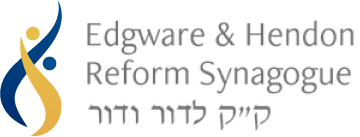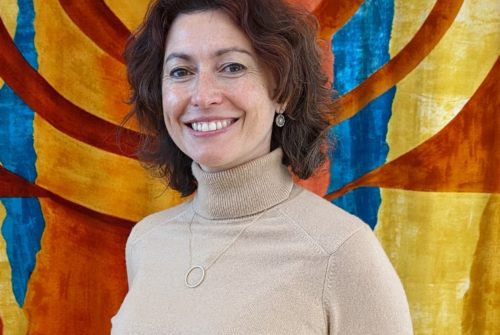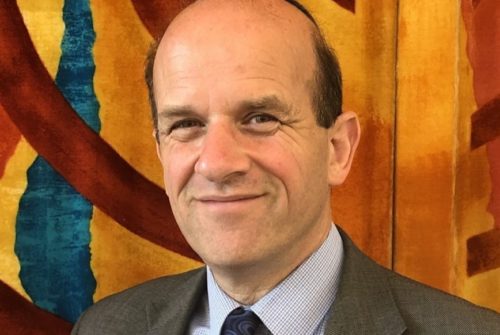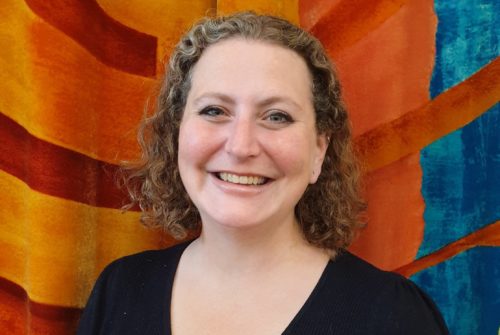Just a month ago our Synagogue lost one of the people on whose presence we could always count, not least in my first year here at EHRS, putting the Siddurim back on the trolley at the back to the shul, Sidney Budd z’’l. Sidney died at the age of 94, having moved some months ago with his wife Sylvia to a nursing home in Newbury. Before they moved, Sidney gave us the contents of his library of contemporary Jewish books for us to give out to members, a gift much appreciated at our day of learning back in December. But that is only one of the gifts that he gave in his lifetime.
One, whose value will be eternal, is this book ‘Towards the Golden Year’ which he wrote in 1985 to document the first fifty years of the Edgware and District Reform Synagogue part of EHRS. In this he tells us how we started in this part of London. I wonder if these origin stories tell you much about our character now. EDRS started in a brouighus – of thirteen members of the Edgware United Synagogue with their shul in 1934. They met in the White Lion Pub and resolved to start what was to be known as the Edgware Progressive Jewish Fellowship and they elected John Chapman z’’l as their Chair (a position he held for nearly 20 years) and Cicely Barnett z’’l as their Hon Secretary. She became our Synagogue’s first Woman President. With the support of West London Synagogue, and its new protégé, founded in 1933, North Western Reform Synagogue, now known as Alyth, by 1935 we had become the third Reform Synagogue to be founded in London – now known as Edgware and District Reform Synagogue. EDRS grew slowly and indeed by 1939, as Sidney notes in his history, Alyth had suggested that there probably wasn’t room for two Reform Synagogues in this part of London, and perhaps we should close down and become part of their congregation. We did in fact stop operating during the Second World War and then re-opened in 1946, ushering a fast period of growth, with our new German Rabbi, Ignaz Maybaum z’’l.
The origin story of Hendon Reform Synagogue, doesn’t start with a brouighus, as far as I can find. Rather Sidney Kinglsey and Ben Fisher z’’l together with other families had the far sighted vision to start a Synagogue in Hendon with Czech Rabbi Dr Arthur Katz z’’l, in 1949, whose Yarzheit we commemorate today. They were clearly meeting a need in the area as the Jewish population was rapidly growing. By 1950 £2600 had secured the congregation the site which became Danescroft, the original home of HRS up until when EDRS and HRS became EHRS together in 2017.
For those who want to admire the farsightedness of our founders, which Sidney’s book certainly helps us to do, This Stonegrove site of our Edgware and Hendon Reform Synagogue was bought originally for just about £5000.
Making Judaism thrive is always about foresight, vision and ambition, whatever the circumstances that get you there and put you in a position where a decision has to be made. It’s the same with the Movement for Reform Judaism of which EHRS is one of the forty-two constituent Synagogue members, and with Liberal Judaism and its now thirty constituent Synagogues. The two movements have very different origin stories, and also a possibility of those stories converging to create something new which may enable all of their 70 Synagogues to be in the strongest position for the future of Judaism in the UK.
The Movement for Reform Judaism began in a brouighus. Sixteen families in 1840 got fed up with the unwillingness of the synagogue to which the majority belonged, Bevis Marks Synagogue, to enable a branch to open nearer their homes in the West End of London, and also for the service to develop in a way that met their needs as British Jews better. They started a Synagogue, soon employing a forward thinking Rabbi from Liverpool, David Woolf Marks to lead the changes that they knew were needed for Judaism to thrive in their families. They called their Synagogue the West London Synagogue of British Jews. Over the coming nearly 100 years just two other Synagogues began with a similar philosophy in Britain, one in Manchester and one in Bradford, until in the 1930’s Glasgow, Hampstead Garden Suburb and Edgware formed Reform congregations. The British Jewish author and journalist Israel Zangwill, was rather rude about West London Synagogue at little after its Golden jubilee in the 1890’s– suggesting that the Synagogue had stood still admiring itself for the past fifty years. It took until 1942 for the Reform Synagogues in the UK to come together into an association, made necessary by the tough task of educating dispersed children in wartime. The formed the Association of Synagogues of Great Britain, succeeded by the Reform Synagogues of Great Britain and now the Movement for Reform Judaism. EDRS joined when it was restarted in 1946 and HRS was part from its earliest days in 1949. It was what it said on the tin – an Association of Synagogues and that autonomy has remained to this day – underscoring the diversity within our Synagogue movement.
Meanwhile in 1902, following the lead of a woman in her 20’s Lily Montagu, who had written and influential paper, the Spiritual Possibilities of Judaism today, another way of living Judaism in the modern era was founded. It was called the Jewish Religious Union for the Advancement of Liberal Judaism. The JRU as it was then known began with an afternoon service held in what is now the Landmark Hotel on Marylebone Road. Its founders and earliest supporters included Claude Montefiore, who was a prominent member of the West London Synagogue, Israel Abrahams, a Jewish academic and Rev Simeon Singer, the Orthodox Rabbi, editor and translator of the Singers prayerbook. What they felt they were aiming to do was to revitalise Judaism for people who were living as Jews in 20th Century Britain. Within a decade they had founded their first Synagogue, the Liberal Jewish Synagogue in St John’s Wood, led by Rabbi Israel Mattuck, an Rabbi from the American Reform movement. The LJS seeded other Synagogues in London and around the country. The Jewish Religious Union become the Union of Liberal and Progressive Synagogues and then, in the 1990’s Liberal Judaism. Because its origins are of a movement which grew through the foundation of Synagogues it has always been a closer union than that of the Movement for Reform Judaism, with a perhaps a clearer sense of movement direction and values.
So where are we now? It won’t be long before Progressive Judaism in its Reform variety has been building in the UK for 200 years. Between Reform and Liberal Judaism. Progressive Judaism is over 70 Synagogues, large and small, throughout the country with around 30-40% of all Synagogue members, depending on how you count it. We have a great diversity of practice but yet a remarkable unity of inclusivity, determination that being Jewish means to be an effective and contributing citizen of the society around us and conviction that we owe a duty to ourselves and our future generations to teach Judaism, do Judaism, think Judaism, as Jews make a difference to the world. Together Reform and Liberal Jews are members of the World Union for Progressive Judaism with more than 1000 Synagogues in over 50 countries and coming on for 2,000,000 Jews, indeed the WUPJ was founded here in London just under 100 years ago. Our Rabbis are trained together at Leo Baeck College, which Reform and Liberal Judaism has been building since nearly 70 years ago. The pinnacle of both the Reform Synagogue’s Youth and the Liberal Judaism Youth movement is the Shnatt Netzer year – a year of living, learning and serving in Israel together at the end of a school career. Reform and Liberal Judaism campaigns and votes together as a caucus in the Board of Deputies and together we help to ensure our voice is heard in the World Zionist Organisation through Arzeinu, the Progressive Jewish voice on Israel, successor to Pro-Zion. Our children, when educated in pluralist and Progressive Jewish Day Schools, do so together, at JCoSS, Clore Shalom, Akiva, Eden and Alma.
We continue currently as two separate movements. Is this the best way to make Progressive Judaism thrive in the years ahead? And that is the question that we are going to be addressing as a congregation, as our Movements and as a Progressive Jewish world in the year or so ahead.
Back in 1983 EDRS and HRS were intimately involved in this question. The key committees that asked that question included EDRS member Don Glazer and our Rabbi Michael Leigh z’’l, they included from HRS Professor Ludwik Finkelstein. At that time, forty years ago, the consensus answer was that the best way forward for Progressive Judaism was for the Reform Synagogues of Great Britain and the Union of Liberal and Progressive Synagogues to remain separate, co-operating for sure but ploughing different furrows in end of twentieth Century Anglo Jewry. Don has kindly shared with me his working documents from that time.
Since that time there has been much development, much convergence between the two movements on a number of issues of Jewish life, much acknowledgment that we can celebrate the diversity of our Synagogues and much development. The proposal that is in front of us this year is to create a New Progressive Jewish Movement that brings the Reform and Liberal Jewish movements together.
This is a journey, the vision of whose destination has been proposed, but which we need as a congregation to consider where and perhaps if we are on it. How are we going to do that?
In the EHRS way, with discussion, learning, thoughtful consideration and input into the process, with engagement and involvement, just as EHRS and HRS did back in 1983. First off next Shabbat, 3rd June, my First Shabbat Shiur at 09:15 will ask the question Reform Judaism and Liberal Judaism: How did we get to where we are today? We will learn more about the history and developing positions of the two movements. Then as our first community forum on the issue, Rabbi Josh Levy newly appointed CEO of the Movement for Reform Judaism and Rabbi Charley Baginsky CEO of Liberal Judaism are coming to EHRS on Thursday 13th July in the evening so that together we can all talk through the opportunities and challenges that such a proposal might bring for us as members of EHRS. These two events are of course only the beginning of a substantial process which will make a great difference to our future as Jews in Britian. I am looking forward to it.
Within our Torah portion of Naso is the blessing we use at the end of all of our services, the priestly blessing: May God bless you and keep you!
May God look kindly upon you and be gracious to you
May God reach out to you in tenderness and give you peace. The last word of this blessing is Shalom. As you may well know the root meaning of Shalom is a word denoting completeness, we even use it in modern Hebrew to l’shalem, pay or complete a transaction. May in our deliberations of the future of thriving Progressive Judaism in the UK, we reach both peace and completeness, speedily in our days!



